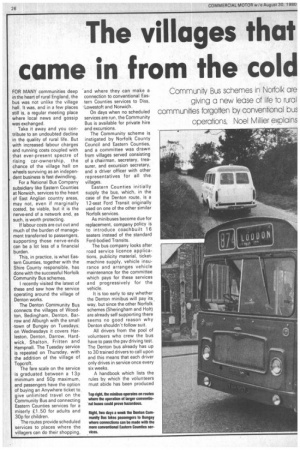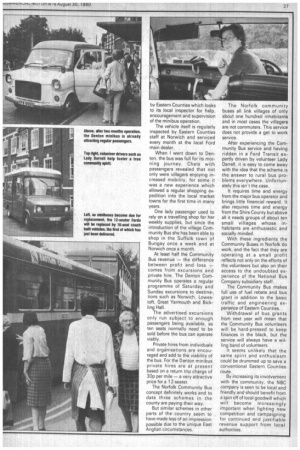The villages that came in from the cold
Page 28

Page 29

If you've noticed an error in this article please click here to report it so we can fix it.
FOR MANY communities deep in the heart of rural England, the bus was not unlike the village hall. It was, and in a few places still is, a regular meeting place where local news and gossip was exchanged.
Take it away and you contribute to an undoubted decline in the quality of rural life. But with increased labour charges and running costs coupled with that ever-present spectre of rising car-ownership, the chance of the village hall on wheels surviving as an independent business is fast dwindling.
For a National Bus Company subsidiary like Eastern Counties at Norwich, services to the heart of East Anglian country areas, may not, even if marginally costed, be viable, but it is the nerve-end of a network and, as such, is worth protecting.
If labour costs are cut out and much of the burden of management transferred to passengers, supporting those nerve-ends can be a lot less of a financial burden.
This, in practice, is what Eastern Counties, together with the Shire County responsible, has done with the successful Norfolk Community Bus schemes.
I recently visited the latest of these and saw how the service operating around the village of Denton works.
The Denton Community Bus connects the villages of Woodton, Bedingham, Denton, Barrow and Alburgh with the small 'town of Bungay on Tuesdays; on Wednesdays it covers Harleston, Demon, Darrow, Hardwick, Shelton, Fritten and Hempnall. The Tuesday service is repeated on Thursday, with the addition of the village of Toperoft.
The fare scale on the service is graduated between a 13p minimum and 50p maximum, and passengers have the option of buying an Anywhere ticket to give unlimited travel on the Community Bus and connecting Eastern Counties services for a miserly £1 .50 for adults and 30p for children.
The routes provide scheduled services to places where the villagers can do their shopping, and where they can make a connection to conventional Eastern Counties services to Diss, ' Lowestoft and Norwich.
On days when no scheduled services are run, the Community Bus is available for private hire and excursions.
The Community scheme is instigated by Norfolk County Council and Eastern Counties, and a committee was drawn from villages served consisting of a chairman, secretary, treasurer, and excursion secretary, and a driver officer with other representatives for all the. villages.
Eastern Counties initially supply the bus, which, in the case of the Denton route, is a 12-seat Ford Transit originally used on one of the other similar Norfolk services.
As minibuses become due for replacement, company policy is to introduce coachbuilt 16 seaters instead of the standard Ford-bodied Transits.
The bus company looks after road service licence applications, publicity material, ticketmachine supply, vehicle insurance and arranges vehicle maintenance for the committee which pays for these services and progressively for the vehicle.
It is too early to say whether the Denton minibus will pay its way, but since the other Norfolk schemes (Sheringham and Holt) are already self supporting there seems no good reason why Denton shouldn't follow suit.
All drivers from the pool of volunteers who crew the bus have to pass the psv driving test. The Demon bus already has up to 30 trained drivers to call upon and this means that each driver only drives in service once every six weeks.
A handbook which lists the rules by which the volunteers must abide has been produced by Eastern Counties which looks to its local inspector for help, encouragement and supervision of the minibus operation.
The vehicle itself is regularly inspected by Eastern Counties staff at Norwich and serviced every month at the local Ford main dealer.
When I went down to Denton, the bus was full for its mor ning journey. Chats with passengers revealed that not only were villagers enjoying in creased mobility, for some it was a new experience which allowed a regular shopping ex pedition into the local market towns for the first time in many years.
One lady passenger used to rely on a travelling shop for her weekly supplies, but since the introduction of the village Community Bus she has been able to shop in the Suffolk town of Bungay once a week and at Norwich once a month.
At least half the Community Bus revenue — the difference between profit and loss — comes from excursions and private hire. The Denton Com munity Bus operates a regular programme of Saturday and Sunday excursions to destina tions such as Norwich, Lowestoft, Great Yarmouth and Bickling Hall.
The advertised excursions only run subject to enough passengers being available, as ten seats normally need to be sold before the bus can operate viably.
Private hires from individuals and org6nisations are encou raged and add to the viability of the bus. For the Denton minibus private hires are at present based on a return trip charge of 30p per mile — a very attractive price for a 12-seater.
The Norfolk Community Bus concept definitely works and to date three schemes in the county are paying their way. But similar schemes in other parts of the country seem to have made less of an impression possible due to the unique East Anglian circumstances. The Norfolk community buses all link villages of only about one hundred inhabitants and in most cases the villagers are not commuters. This service does not provide a get to work service.
After experiencing the Community Bus service and having ridden in a Ford Transit expertly driven by volunteer Lady Darrell, it is easy to come away with the idea that the scheme is the answer to rural bus problems everywhere. Unfortunately this isn't the case.
It requires time and energy from the major bus operator and brings little financial reward. It also requires time and energy from the Shire County but above all it needs groups of about ten small villages whose inhabitants are enthusiastic and socially minded.
With these ingredients the Community Buses in Norfolk do work, and the fact that they are operating at a small profit reflects not only on the efforts of the volunteers but also on their access to the undoubted experience of the National Bus Company subsidiary staff.
The Community Bus makes full use of fuel rebate and bus grant in addition to the basic traffic and engineering experience of Eastern Counties.
Withdrawal of bus grants from next year will mean that the Community Bus volunteers will be hard-pressed to keep finances in the black, but the service will always have a willing band of volunteers.
It seems unlikely that the same spirit and enthusiasm could be drummed up to save a conventional Eastern Counties route.
By increasing its involvement with the community, the NBC company is seen to be local and friendly and should benefit from a spin off of local goodwill which will become increasingly important when fighting new competition and campaigning for continued and justifiable revenue support from local authorities.




























































































